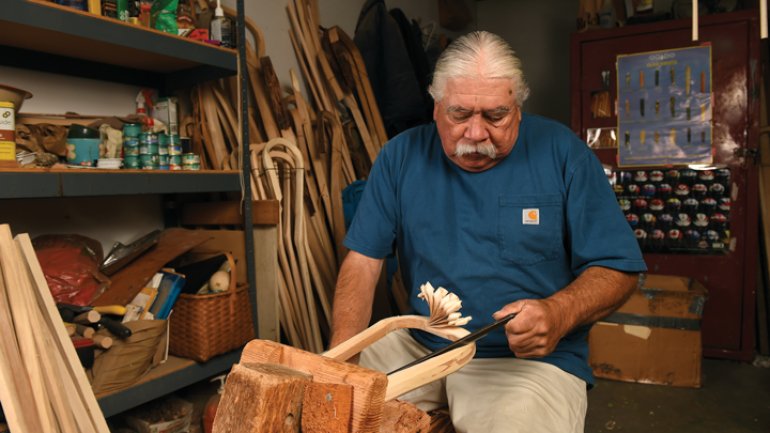The Onondaga Art of Shaping Sticks
The Onondaga Art of Shaping Sticks
↑ It takes months for Jacques to steam, bend, form, and dry lacrosse sticks. He then removes the remainder of the bark and hand-shapes the heads of the sticks.
Photo: John Berry
Just east of the Finger Lakes and south of Syracuse in central New York is the Onondaga Nation, one of the original five nations that established the Haudenosaunee Confederacy – the People of the Longhouse – one of the first participatory democracies in the world. There, in a modest cinder block and corrugated metal building set in the leeward side of a hill, Alfie Jacques of the Onondaga Turtle Clan continues to make lacrosse sticks from local hickory – much as he has for nearly six decades, since he was 13.
The game of lacrosse is better known in its modern form, a sport played at elite universities and youth programs. That sport, however, is the result of systematic appropriation and erasure of Native culture in the United States and Canada. By the time the “official” rules of the game had been established by white Canadian enthusiasts led by George Beers in 1867, lacrosse had been methodically altered to restrict Native control of its play and limit their skills to the benefit of amateur non-Native players.
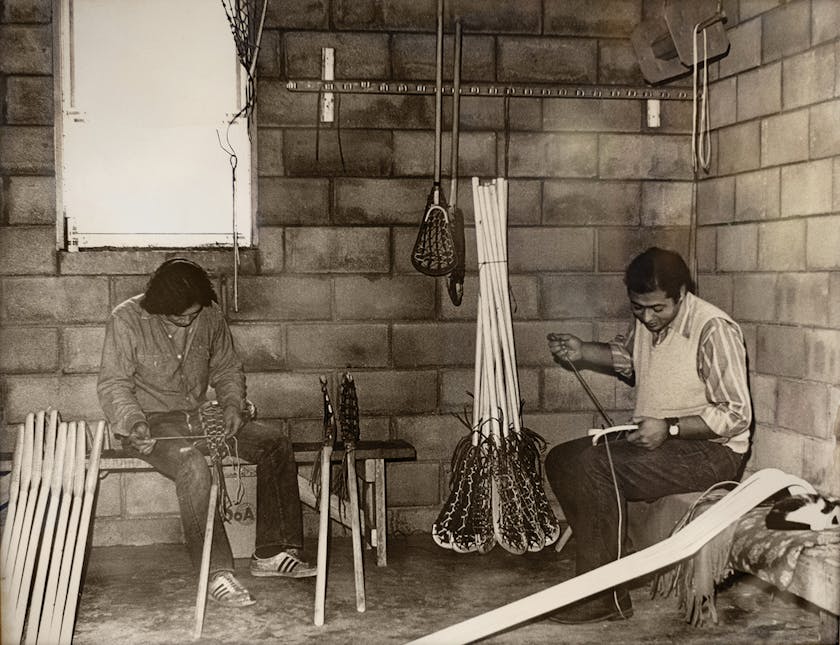
↑ A vintage photo of Alfie Jacques (left, pictured with a worker) stringing the pocket of a wood lacrosse stick.
Photo: Alexandra Moreo
“People think that the ‘savage Indians’ played a game so rough that people were killed, and not about the religious ceremony that accompanied the game. They want to see it as a war game,” laments Jacques. But Deyhontsigwa’eh (They Bump Hips) is a gift of the Creator to the Haudenosaunee and has been played for generations. The “Creator’s Game,” or “Medicine Game,” is played by the Onondaga to give thanks.
“You thank the Creator for the earth, the sun, the air – everything that made the tree and the stick,” Jacques told Chloe Gersten in a 2017 interview for Deyhontsigwa’ehs: The Creator’s Game Lacrosse Weekend.
The traditional, wooden lacrosse stick is vital, and an expertly crafted one is a wonder to hold and use. Heavier than its modern-day plastic and metal counterpart, it courses with the life of the wood from which it is fashioned. Hundred-year-old straight-grained hickory is selected and cut after the leaves have fallen and the sap has drained to ensure the wood will not crack during bending. A seed is planted to replace each tree. Logs are split into rails and dried for more than a month before steaming, which allows the hickory to be bent over a metal form, creating the lacrosse stick’s distinctive crook shape. The bend is secured with wire and left to dry. A second, slight reverse bend is later put in below what forms the head of the stick, and it is left to dry again in a vise.
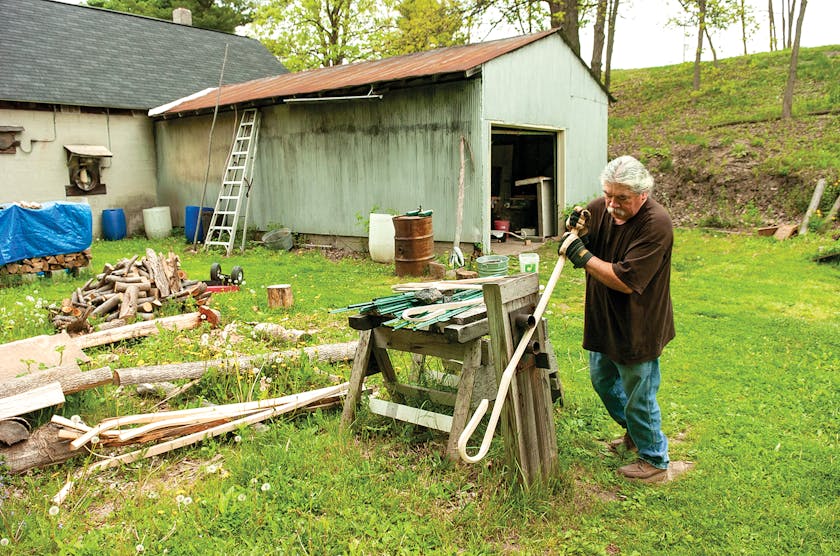
↑ To shape the heads of his lacrosse sticks, Jacques steams then bends 100-year-old hickory by hand.
Photo: John Berry
After months of forming and subsequent drying, the remainder of the bark is removed and the flat “scoop” of the stick’s head and the round shaft of the handle are hand-shaped using a drawknife. The stick is sanded and shellacked, and the gut, leather, and synthetic strings are strung to form the pocket that defines the stick’s function.
Even with the establishment of the modern, non-ritual-based game of lacrosse, the wooden stick continued to be used by players across North America and produced by makers such as Alfie and his father, Louis. Prior to the development of the industrially produced sticks in the early 1970s, Alfie and Louis could produce as many as 12,000 wooden sticks a year. A photograph of their workshop from 1972 shows the ground cleared of the standing hickory trees that now grow close by, and the heaps of cut logs give the place the aura of a sawmill. While the plastic stick allowed the modern game to expand exponentially, annual demand for the Jacqueses’ handmade wood sticks abruptly diminished from 12,000 to 1,200.
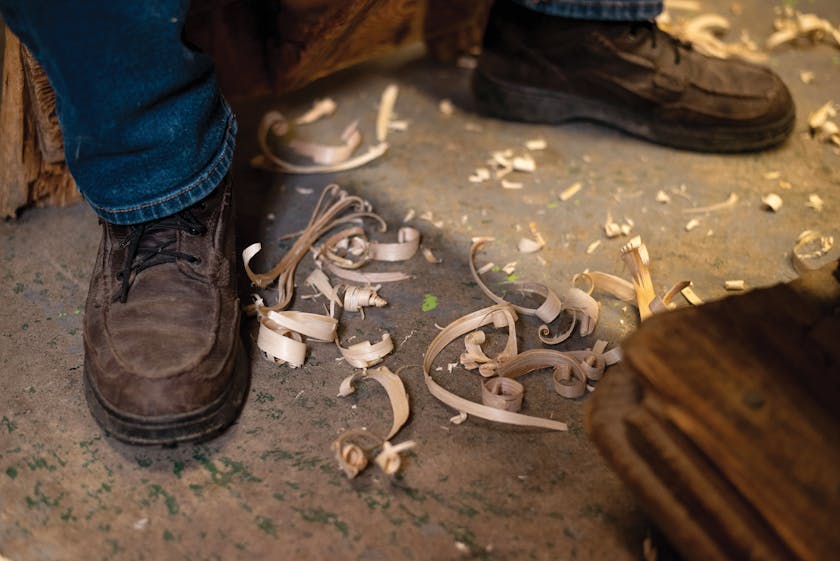
↑ Photo: Alexandra Moreo
“I loved the lacrosse stick for what it was. It grabbed me. It pulled me in. It was calling me. It won’t let me go.” ~ Alfie Jacques
Although the mass-market for wooden sticks has disappeared, Jacques’ most important clientele – the Onondaga – has not. Crib sticks are given to Onondaga boys after birth, and men are buried with their sticks so that they may continue to play the Creator’s Game among their ancestors. Many Onondaga today still opt to play the fast-paced, indoor “box” version of the modern game with a wooden stick. Most crucially, it is the game played for the greater community of the Onondaga that simply cannot be played without the wooden stick.
“When I was a little kid, and I saw my father’s stick – this bent piece of wood – I was attracted to it, not knowing what it was or what it did,” Jacques recalls. “Ever since then, I loved the lacrosse stick for what it was. It grabbed me. It pulled me in. It was calling me. It won’t let me go.” Jacques has played an irreplaceable role for his community by continuing to split, steam, bend, and shape by hand the hickory lacrosse sticks the Onondaga use to maintain the thread between their past, present, and future.
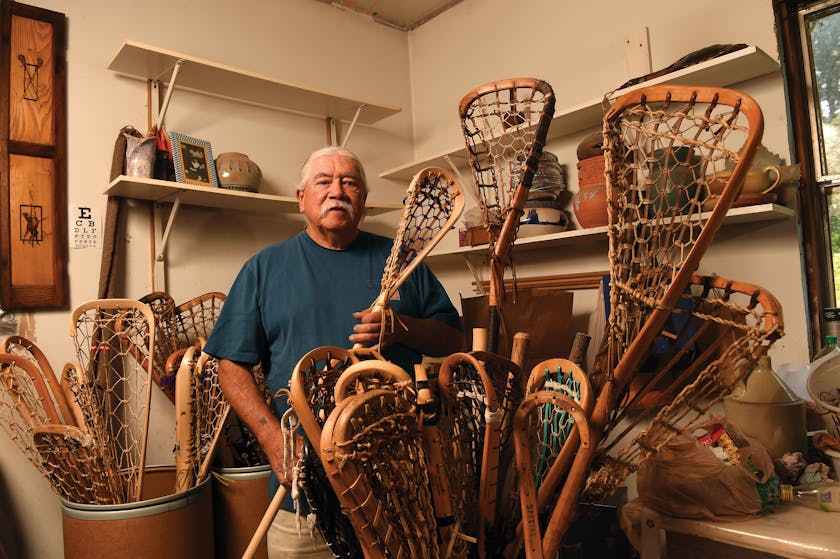
↑ The Medicine Game – known to many as lacrosse – has been played by the Onondaga for generations to give thanks to the Creator.
Photo: John Berry
“I feel I’m doing much more right now for the game by continuing to make wooden sticks,” Jacques, who intends to keep making them as long as he’s physically able to, tells Gersten. “This is what I have dedicated my life to do: making a good lacrosse stick, the traditional way.”
Inspired by Alfie's craft?
We'd love to hear from you. Send your reactions, reflections, questions, and concerns to [email protected].
We need your help to share artists' stories
Become an American Craft Council member and support nonprofit craft publishing. You won't just receive our magazine – you'll help grow the number of lives craft has touched.
